User Interface Guide
This document describes the operation of the user interface. For more information about each module, refer to Modules Guide.
Project
![]()
The project file can be saved and contains all the preset and sound data. When the project file is opened, all the data is recalled. The file extension for the project file is .2020.
Keyboard Interactions
| Modifier | Event | Description |
|---|---|---|
Command | N | Start a new project. |
Command | S | Save the project file. |
Command + Shift | S | Save the project file under a different name. |
Command | O | Open a project file. |
Context Menu

The Context Menu provides a way to control the module or GUI located where you right-clicked.
Preset Selector


Certain modules come equipped with a preset feature, which enables you to save and restore the state of all parameters within the module. These modules offer either 10 or 80 preset slots, which can be conveniently accessed through the keys displayed on the GUI. Specifically, the Q W E R T Y U I O P keys are designated for song presets, while the A S D F G H J K keys are designated for pattern presets.
Mouse and Keyboard Interactions
| Modifier | Event | Description |
|---|---|---|
| - | Q W E R T Y U I O P | Restore the preset at the beginning of the next bar. |
Control | Q W E R T Y U I O P | Restore the preset immediately. |
Shift | Q W E R T Y U I O P | Save the preset. |
| - | A S D F G H J K | Restore the preset at the beginning of the next bar. |
Control | A S D F G H J K | Restore the preset immediately. |
Shift | A S D F G H J K | Save the preset. |
Disabling Preset Recall
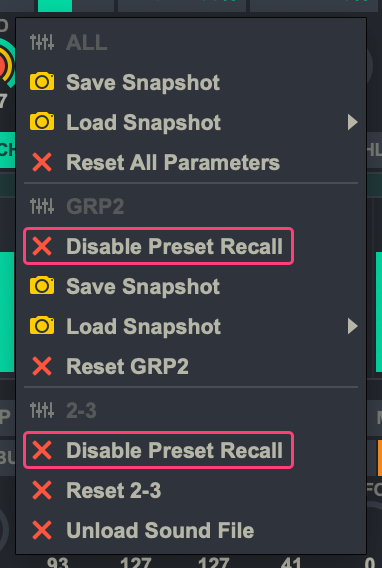
To disable preset recall, right-click and select “Disable Preset Recall”. This is useful if you do not want some modules to follow a preset.
Snapshots
![]()
The Snapshots feature allows you to save states of frequently used sounds and sequences for reuse. You can save snapshots for the entire app or for each module with a preset GUI. Snapshots can be saved from the context menu, and the files are saved to ~/Music/2020/Snapshots.
Basic GUI components

These are basic GUI components for adjusting parameter values and toggling ON/OFF switches. The knobs included in modules capable of receiving trigger events are equipped with a randomize function. Randomizable knobs display the probability and range as red and yellow lines respectively.
Mouse and Keyboard Interactions
| Modifier | Event | Description |
|---|---|---|
| - | Double Click a component | Resets value to default. |
| - | Click a Toggle component | Toggles value ON/OFF. |
| - | Drag a Knob or Number Box | Changes the value. |
Shift | Drag a Knob or Number Box | Changes the value faster. |
| - | Drag a Slider | Changes the value. |
Alt | Drag a Randomizable Knob | Changes the randomizing range. |
Command | Drag a Randomizable Knob | Changes the randomizing probability. |
Sound File Menu
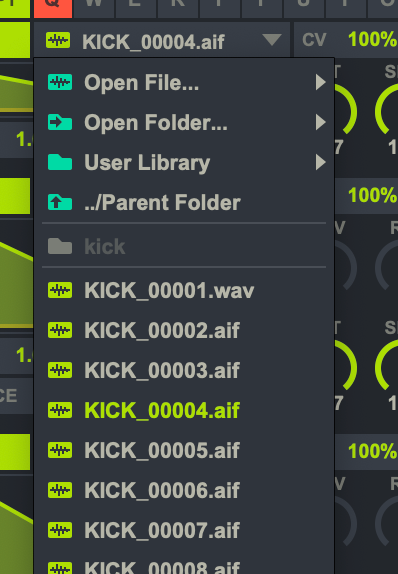
The Sound File Menu allows you to browse and load sound files. The sound files and folders located in ~/Music/2020/Sounds can be browsed using the User Library menu. You can also open sound files and folders by dragging and dropping them.
Transport Control

You can control the BPM, swing, play, and stop. Clicking the play button again while playing will rewind to the beginning of the bar. Clicking the stop button while stopped will kill all audio. When manually syncing with other music, the tap tempo and BPM adjustment buttons are handy.
Keyboard interactions
| Modifier | Event | Description |
|---|---|---|
| - | SPACEBAR | Toggle play/stop. |
| - | LEFT ARROW | Temporarily decrease BPM. |
| - | RIGHT ARROW | Temporarily increase BPM. |
Dejavu

Dejavu turns parameter randomizers into generative sequencers. It creates up to 32 generation histories for ALL parameter randomizers and sequentially reproduces past random numbers based on a set probability and length.
For instance, if you set the probability to 100% and the length to 8, the randomizer will work as an 8-step sequencer of repeating values generated 8 times in the past. Conversely, if you set the probability to 0%, the sequence will always be random. And, setting the probability to 1-99% will result in a gradually changing sequence. What’s intriguing is that the progression of the reproduced steps is independent of the BPM clock or measures; instead, it is triggered by the instrument itself. This means that even with a length of 8, the number of beats each module loops is determined by the triggering frequency. As you adjust the Dejavu parameters, you’ll uncover new ways to create build-ups and transitions in your music.
Adjust the DJV and LEN parameters located on the right part of the clock module to control the global Dejavu parameters.
Otherwise they can be set per module via OSC or MIDI with an address like /group1/dejavu/prob.
Grid Sequencer

The Grid Sequencer allows you to set and play trigger sequences. The sequence resolution can be set to each beat. Additionally, you can edit the sequence using the multiple buttons located in the upper right corner.
Mouse Interactions
| Modifier | Event | Description |
|---|---|---|
| - | Click or Drag over cells | Toggle triggers. |
Command | Click or Drag over cells | Toggle accents. |
Shift | Drag over cells | Changes the volume sequence. |
Alt | Drag and drop | Copies sequences by beat unit. |
| - | Execute Duplicate Sequence from the context menu | Duplicates the current sequence to the end position. |
| - | Execute Double Tempo from the context menu | Rearrange grids to play the current sequence at double the speed. |
| - | Execute Halve Tempo from the context menu | Rearrange grids to play the current sequence at half the speed. |
Envelope

The envelope can be edited to make changes to parameters such as volume, pitch, and granular parameters that correspond to the flow of time. If you’re using an FM synthesizer or granular sampler, you can select and edit specific envelopes from among multiple envelopes using the algorithm selector or tab. You can also randomize the coordinates of the envelope points.
Mouse Interactions
| Modifier | Event | Description |
|---|---|---|
| - | Drag a point | Moves the envelope point. |
| - | Drag a line between points up or down | Changes the curve of the envelope. |
Alt | Drag a point | Changes the range of randomization. |
Command | Mouse over | Switches to the pitch envelope. |
Audio Bus

The audio signal of the instrument module can be sent to any BUS. For example, if you want to send it directly to the mixer, you can enable BUS1. If you want to process it with an FX module, you can enable FX2.
FX Patcher
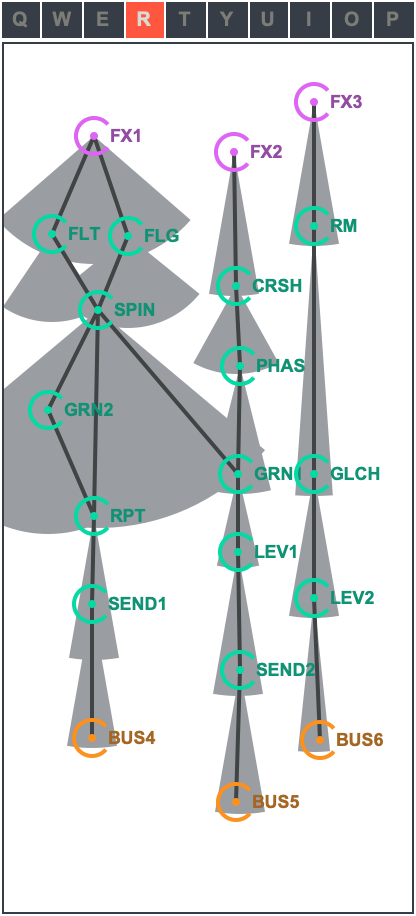
You can freely connect modules represented by nodes. The circular arc displayed on each node indicates the range for connecting it to another node.
Mouse Interactions
| Modifier | Event | Description |
|---|---|---|
| - | Drag a node | Moves the node. |
Alt | Drag a node | Changes the connection range of the node. |
Trigger Events (CV)

When you enable any FX BUS (FX1, FX2, FX3) and trigger it, you can control the FX module connected in the FX patcher with a CV signal. In the FX module, if the CV signal exceeds the threshold, parameter randomization and LFO reset are executed. If the CV signal falls below the threshold, the CV signal is not passed to the next module. In addition, the CV signals are added together.
Note that CV signals are designed for internal use only and cannot drive hardware synthesizers.
Mute


When MUTE GRP is on, instruments within the same group that are using the same busses will mute each other when triggered.
FM Algorithm

You can switch algorithms and toggle the display of operator editors from 1 to 3.
Mouse Interactions
| Modifier | Event | Description |
|---|---|---|
| - | Click a operator | Displays the clicked operator in the editor. |
| - | Click outside of operators | Switchs algorithms. |
Equalizer
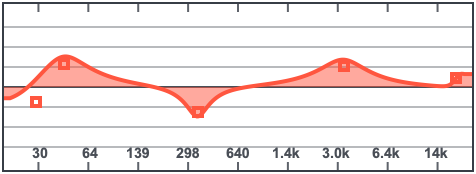
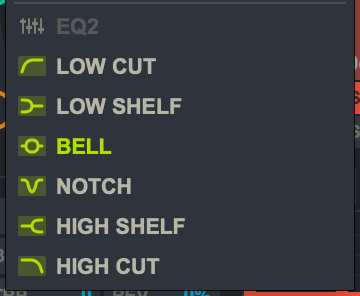
You can adjust the EQ points by moving them in any direction. Moving them left and right controls the frequency, while moving them up and down controls the volume. By changing the Q value, you can adjust the sharpness of the EQ.
Mouse Interactions
| Modifier | Event | Description |
|---|---|---|
| - | Drag a point | Moves the EQ point. |
Alt | Drag a point | Changes the Q value of the EQ point. |
| - | Right-click on a point and select a filter type from the context menu | Selects the EQ type. |
Learn Mode

In Learn mode, you can assign MIDI controllers or keys to the selected parameter. However, note that keys that are already assigned globally, such as those for presets or instruments, cannot be assigned.
To remove a mapping, press the Delete key while in Learn mode.
Keyboard Interactions
| Modifier | Event | Description |
|---|---|---|
Command | L | Toggle LEARN mode. |
Recordings

Output Location
Recorded files are stored in ~/Music/2020/Recordings.
Recording settings can be configured in Preferences.
File Format
Wav or Aiff can be selected as the file format.
BIT DEPTH can be selected from 16-bit, 24-bit and 32-bit (Wav only).
Recording Channel Set
The channel set for recording can be selected from the following.
2 Ch Mix: OUT1 + OUT24 Ch Stem: MST1 / MST212 Ch Stem: BUS1 / BUS2 / BUS3 / BUS4 / BUS5 / BUS6
If you want to record a stem and re-mix it completely in another DAW, please try the Wav 32-bit format. It allows signals above 0 dB to be recorded correctly. Be careful not to damage your equipment or your ears.
Output File Name
Recording file names can be specified in NAME FORMAT using {project}, {bpm}, {year}, {month}, {day}, {hour}, {minute}, and {second} as placeholders.
Sync with Ableton Link Integration
 Ableton Link integration allows tight clock synchronization between devices on the same network.
It can be enabled via the Preferences window or the Options menu.
If you want to sync with MIDI clocks, use another utility app as a bridge.
Ableton Link integration allows tight clock synchronization between devices on the same network.
It can be enabled via the Preferences window or the Options menu.
If you want to sync with MIDI clocks, use another utility app as a bridge.
Options
| Option | Description |
|---|---|
START/STOP | sync start and stop commands across all connected apps that have Start Stop Sync enabled. |
DLY | Adjust the sync delay time in ms. Negative values can also be set. |
MIDI
 You can configure MIDI input settings in Preferences. Enabling
You can configure MIDI input settings in Preferences. Enabling FEEDBACK will transmit parameter changes within the app to the MIDI device.
OSC
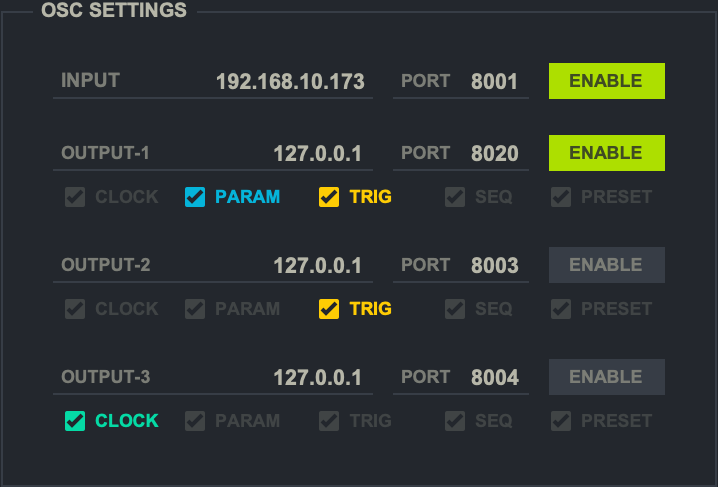
You can send and receive parameters using Open Sound Control (OSC). Only the parameters belonging to the checked category among Clock, Parameter, Trigger, Sequence, and Preset will be sent. Please refer to the Parameter list for the OSC addresses that can be sent and received.
Color Themes


You have the option to customize the color scheme of the GUI. There are 11 colors available to set: Background, Base, Text, Blue, Green, Orange, Pink, Purple, Red, Teal, and Yellow. You can toggle between dark mode and light mode as well. Feel free to get creative with your own color combinations and share them if you come up with a good theme.
Configuring the Keyboard Layout
By default, 2020 is designed for a QWERTY keyboard.
If you are using a non-QWERTY keyboard layout, you can change the key mapping by editing the mappings.config file.
- Quit 2020.
- Choose
Go>Go to Folderfrom the Finder menu. - Type
~/Library/Containers/com.dubrussell.2020beatmachine/Data/Library/Application Support/com.dubrussell.2020beatmachine/and press Enter. - Edit
mappings.configwith any text editor. - Open 2020 again after editing.
The default key mapping looks like this
<key key="q" parameter="/preset/q"/>
<key key="w" parameter="/preset/w"/>
<key key="e" parameter="/preset/e"/>
<key key="r" parameter="/preset/r"/>
<key key="t" parameter="/preset/t"/>
<key key="y" parameter="/preset/y"/>
<key key="u" parameter="/preset/u"/>
<key key="i" parameter="/preset/i"/>
<key key="o" parameter="/preset/o"/>
<key key="p" parameter="/preset/p"/>
<key key="a" parameter="/preset/a"/>
<key key="s" parameter="/preset/s"/>
<key key="d" parameter="/preset/d"/>
<key key="f" parameter="/preset/f"/>
<key key="g" parameter="/preset/g"/>
<key key="h" parameter="/preset/h"/>
<key key="j" parameter="/preset/j"/>
<key key="k" parameter="/preset/k"/>
<key key="z" parameter="/group1/1/enable"/>
<key key="x" parameter="/group1/2/enable"/>
<key key="x" parameter="/group1/3/enable"/>
<key key="c" parameter="/group2/1/enable"/>
<key key="c" parameter="/group2/2/enable"/>
<key key="v" parameter="/group2/3/enable"/>
<key key="b" parameter="/group3/enable"/>
<key key="n" parameter="/group4/enable"/>
<key key="m" parameter="/slicer/enable"/>
<key key="spacebar" parameter="/clock/play"/>
<key key="cursor left" parameter="/clock/bpm/slower"/>
<key key="cursor right" parameter="/clock/bpm/faster"/>You can change the key=“q” part to assign it to a different key.
To remove a key assignment, change it to key=“”.